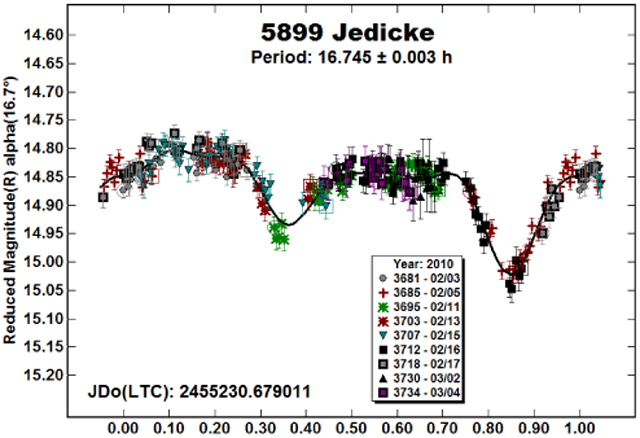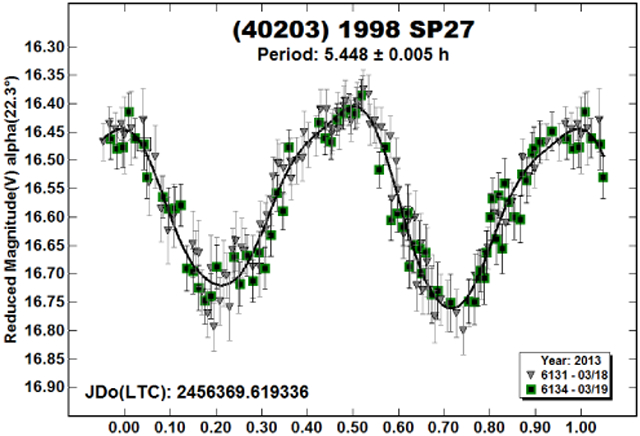Abstract
Lightcurves for nine asteroids were obtained at the Palmer Divide Observatory (PDO) in 2013 February and March. These represent the final objects out of more than 1100 lightcurves measured at PDO over fourteen years. Of the nine objects reported here, six were Hungaria members, two were NEAs, and the remaining two were main belt members. Analysis of the data resulted in a revised rotation period for the Hungaria member 4531 Asaro. The near-Earth asteroid (5828) 1991 AM was found to be a possible binary system with an unusual lightcurve for the secondary period, while follow-up on known Hungaria binary 5899 Jedicke lead to a revised period for the primary and confirmation of the orbital period of the satellite.
CCD photometric observations of nine asteroids were made at the Palmer Divide Observatory (PDO) in 2013 February and March. See the introduction in Warner (2010b) for a discussion of equipment, analysis software and methods, and overview of the lightcurve plot scaling. These were the last observations to be made at PDO, which was razed soon after and the telescopes moved to the California desert where they will be operated remotely. From 1999 April through 2013 March, more than 1100 asteroid lightcurves were obtained and published as a result of work at PDO. Within these numbers are the primary discoveries of more than a dozen Hungaria binary asteroids as well as primary or co-discovery of nearly another dozen.
In the plots below, the “Reduced Magnitude” is Johnson V or Cousins R (indicated in the Y-axis title) corrected to unity distance by applying −5*log (rΔ) to the measured sky magnitudes with r and Δ being, respectively, the Sun-asteroid and Earth-asteroid distances in AU. The magnitudes were normalized to the phase angle given in parentheses, e.g., alpha(6.5°), using G = 0.15, unless otherwise stated. The horizontal axis is the rotational phase, ranging from 0.0 to 1.0.
For the sake of brevity, only some of the previously reported results may be referenced in the discussions on specific asteroids. For a more complete listing, the reader is referred to the asteroid lightcurve database (LCDB, Warner et al., 2009). The on-line version allows direct queries that can be filtered a number of ways and the results saved to a text file. A set of text files, including the references with bibcodes, is also available for download at http://www.minorplanet.info/lightcurvedatabase.html. Readers are strongly encouraged to obtain, when possible, the original references listed in the LCDB for their work.
4531 Asaro.
This Hungaria was previously worked by Warner (2010), at which time the period was reported to be 5.736 h with an asymmetrical trimodal lightcurve and amplitude of 0.29 mag. The data obtained in 2013 produced a completely different period, 4.144 h, with a bimodal lightcurve of amplitude 0.19 mag. In most cases, if the phase angle is not too severe and assuming an object with a “normal” (potato-like) shape, the lightcurve with an amplitude of almost 0.3 mag should be bimodal and nearly symmetrical. Since this was not the case and the 2013 lightcurve seemed well-determined, even if its amplitude was 0.1 mag less, the original 2010 data were reanalyzed to see if they could be fit to a period near 4.14 h. This proved to be the case as a period of 4.15 h was found and, in fact, had a significantly lower RMS fit value than that for the original period. A plot showing the revised 2010 lightcurve is included below.
(5828) 1991 AM.
Observations from 2013 February and March showed this near-Earth asteroid (NEA) to be a possible binary system. The primary lightcurve has a period is 2.6666 ± 0.0002 h and amplitude of 0.15 ± 0.01 mag. These are parameters that are consistent with a small binary system where the primary rotation rate increased to the point it shed mass and a satellite was formed. It is the shape of the secondary lightcurve that makes this an unusual object.
A typical lightcurve due to a satellite has either an upbowed or flat shape with drops from the general “curve” due to occultations or eclipses involving the satellite (so called mutual events; see the lightcurves for 5899 Jedicke below). If the viewing geometry isn’t right to see these events, there will still be a secondary curve with the upbow shape due to rotation of the elongated satellite tidally-locked to its orbital period, or a bimodal curve, indicating a satellite’s rotation that is not tidally-locked.
Two proposed solutions for a satellite are shown below along with a period spectrum. Neither of these fit well with the descriptions above and are not overly convincing. There seems to be little doubt that a second period is present: the lightcurve without subtracting one of the two long periods is almost indiscernible. However, the physical characteristics of the system remain a mystery and observations at future apparitions are strongly encouraged.
5899 Jedicke.
This Hungaria was found to be a binary system by Warner et al. (2010a, 2010b). At that time, a primary rotation period of 3.66 h was found, but the amplitude was too low to eliminate other possible periods. The period of the mutual events (orbital period) was well-established, however, at 16.7 h. The 2013 data also showed a small amplitude for the primary. In both apparitions, the second period lightcurve, which showed pronounced mutual events, was easier to determine first. It was then subtracted from the data set to look for the primary period.
The result was that the period spectrum for the primary period in 2013 (see below) shows a somewhat significant preference for a period of about 2.75 h. Based on this, the PDO data from 2010, a subset of that used by Warner et al. in 2010, was reanalyzed such that the primary period was forced to between 2 and 3 h. The primary and orbital periods that came from that analysis are in close agreement with the 2013 results and the 3.66 h solution, while still present, was not as strong as one for 2.75 h. Therefore, it is proposed that a period of 2.748 h be adopted for the primary.
8024 Robertwhite.
This appears to be the first reported period in the literature. The 0.95 mag amplitude implies an a/b ratio of about 2.5:1 for a triaxial ellipsoid at an equatorial view.
(33908) 2000 LL6.
No previously reported period could be found.
(40203) 1998 SP27.
This was follow-up to observations in 2009 (Warner 2010a). The periods from the two apparitions are in good agreement and the amplitudes essentially the same. Since the phase angle bisector longitudes (LPAB) were about 100° apart, this could be interpreted to mean that the spin axis of the asteroid has a low to modest obliquity.
(68216) 2001 CV26.
This NEA has been observed on numerous occasions (e.g., Hicks 2010; Polishook 2012; Hills 2013). All reported a period of about 2.4 h, in agreement with the 2013 results from PDO.
(88141) 2000 WE174.
This outer main-belt asteroid was in the same field as 5899 Jedicke on one night. Despite having data covering more than one cycle, the period should be taken with some doubt given the large error bars and unusual shape of the lightcurve.
(94608) 2001 VR109.
A member of the Flora group, 2001 VR109 was another target of opportunity. The large amplitude gave promise of finding a reasonable solution and a telescope was made available for a second night for additional observations.


















Table I.
Observing circumstances. Asteroids with (H) after the name are members of the Hungaria group/family. Asteroids with (N) after the name are near-Earth asteroids (q < 1.3 AU). The phase angle (α) is given at the start and end of each date range, unless it reached a minimum, which is then the second of three values. If a single value is given, the phase angle did not change significantly and the average value is given. LPAB and BPAB are each the average phase angle bisector longitude and latitude, unless two values are given (first/last date in range).
| Number | Name | 2013 (mm/dd) | Pts | Phase | LPAB | BPAB | Period | P.E. | Amp | A.E. |
|---|---|---|---|---|---|---|---|---|---|---|
| 4531 | Asaro (H) | 03/18–03/19 | 142 | 10.9,10.2 | 190 | +7 | 4.144 | 0.005 | 0.19 | 0.02 |
| 4531 | Asaro (H) | 10/18–10/31^ | 139 | 26.4,23.3 | 65 | +22 | 4.15 | 0.01 | 0.29 | 0.03 |
| 5828 | 1991 AM (N) | 02/19–03/15 | 273 | 24.8,55.2 | 145 | +32 | 2.6666* | 0.0002 | 0.15 | 0.01 |
| 5899 | Jedicke (H) | 03/02–03/15 | 384 | 13.5,14.9 | 166 | +23 | 2.7481* | 0.0004 | 0.05 | 0.01 |
| 5899 | Jedicke (H) | 02/03–03/04# | 251 | 16.0,27.0 | 112 | −1 | 2.730* | 0.001 | 0.04 | 0.01 |
| 8024 | Robertwhite (H) | 03/18–03/19 | 137 | 5.6,4.9 | 184 | +4 | 7.067 | 0.005 | 0.95 | 0.02 |
| 33908 | 2000 LL6 (H) | 03/11–03/14 | 79 | 23.7,23.8 | 175 | +36 | 5.91 | 0.01 | 0.25 | 0.02 |
| 40203 | 1998 SP27 (H) | 03/18–03/19 | 168 | 22.3,22.2 | 181 | +32 | 5.448 | 0.005 | 0.38 | 0.02 |
| 68216 | 2001 CV26 (N) | 03/11–03/15 | 200 | 25.6,22.0 | 175 | +19 | 2.4290 | 0.0002 | 0.21 | 0.01 |
| 88141 | 2000 WE174 | 03/11 | 56 | 9.8 | 165 | +26 | 3.01 | 0.05 | 0.28 | 0.03 |
| 94608 | 2001 VR109 | 03/14–03/15 | 93 | 10.0,10.5 | 159 | −6 | 6.02 | 0.05 | 0.60 | 0.04 |
2009
2010
period of the primary
Acknowledgements
Funding for observations at the Palmer Divide Observatory was provided by NASA grant NNX10AL35G, by National Science Foundation grant AST-1032896.
Footnotes
Editor’s Note: A hearty congratulations and “farewell and thank you” to the Palomar Divide Observatory. The lightcurve community looks forward to new results from these instruments forthcoming from their new location and ongoing contributions from the author.
References
- Hicks M, Lawrence K, Somers J, and Foster J (2010). Astronomer's Telegram 2502. http://www.astronomerstelegram.org [Google Scholar]
- Hills K (2013). “Asteroid Lightcurve Analysis at Riverland Dingo Observatory (RDO): 501 Urhixidur, 1897 Hind, 1928 Summa, 6261 Chione, and (68216) 2001 CV 26.” Minor Planet Bul. 40, 12–13. [Google Scholar]
- Polishook D (2012). “Lightcurves and Spin Periods of Near-Earth Asteroids, The Wise Observatory, 2005 – 2010.” Minor Planet Bul. 39, 187–192. [Google Scholar]
- Warner BD (2010a). “Asteroid Lightcurve Analysis at the Palmer Divide Observatory: 2009 September-December.” Minor Planet Bul. 37, 57–64. [PMC free article] [PubMed] [Google Scholar]
- Warner BD (2010b). “Asteroid Lightcurve Analysis at the Palmer Divide Observatory: 2010 March – June.” Minor Planet Bul. 37, 161–165. [PMC free article] [PubMed] [Google Scholar]
- Warner BD, Harris AW, Pravec P, and Pollock J (2010a). CBET 2188. [Google Scholar]
- Warner BD, Pravec P, Kusnirak P, Harris A, Pray DP, Pollock J, Reichart D, Ivarsen K, Haislip J, Lacluyze A, and Nysewander M (2010b). “Lightcurve Analysis of 5899 Jedicke: A New Hungaria Binary.” Minor Planet Bul. 37, 123–124. [Google Scholar]


